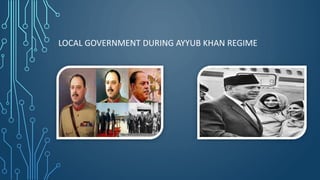
Local government during ayub khan regime
- 1. LOCAL GOVERNMENT DURING AYYUB KHAN REGIME
- 2. BASIC DEMOCRACY • Ayub Khan issued an ordinance of Basic Democracies on October 27, 1959 and introduced the system of Local Governments in Pakistan. • The Basic democracies system was designed to accomplish multiple political objectives. • It was expected both to mobilize the mass of the people, especially in rural areas for development activities and to give them a sense of active participation in local affairs.
- 3. BASIC DEMOCRACIES ORGANIZATION It was a four tiered hierarchical structure consisting of :- • The Union Council • The Tehsil council • The District Council • The Divisional Council
- 4. THE UNION COUNCIL • This was the lowest but the basic tier of the system. • The Union Council consisted of 5-8 villages of about 8,000- 15,000 population. • There used to be 10-15 electoral wards and from each ward one councilor was to be elected by the adult franchise rule. • A person of 21 year old can cast vote. Functions: These councils were given different functions such as • Judicial, Economic ,Agriculture ,Industrial • Communication development • Food production development. • Lastly this union council was converted into Electoral College for the election of President and the members of assemblies.
- 5. THE TEHSIL COUNCIL • The next higher tier was called Tehsil council. • There was no election to this council. • It consisted of some official and some non-official members. • The non-official members were the chairmen of all the Union Councils within the Tehsil and the official members were the heads of all the nation building departments in the tehsil. • The number of official members was equal to those of non-official members. • This council was headed by the Assistant Commissioner of the area. Functions:- • It act as a coordinating body between the union council and district council.
- 6. THE DISTRICT COUNCIL • The most important tier was the district council. • The head of the council was the Deputy Commissioner of the district and the Vice-Chairman used to be selected from amongst the chairmen of the tehsil or Union Councils by the deputy commissioner. • This council consisted of official and non- official members and the number of both officials and non-officials was equal. Functions:- • It performs vast financial and executive powers. In addition to the development functions, it could impose any tax. The functions and powers of the Deputy Commissioner were divided into 1. compulsory:- • Compulsory functions included • The provision and maintenance of schools • Libraries, Hospitals ,Public roads ,Play grounds, 2. Optional:- • The optional functions include provision of secondary and higher secondary education, the Culture, social, economic welfare of people.
- 7. THE DIVISIONAL COUNCIL • The upper most tier was the divisional council. • It was headed by the Divisional commissioner. • The members of the divisional councils consisted of the • Deputy Commissioner • the Vice-chairmen of the districts within the division • the divisional level officers as official members • some other prominent persons to be selected by the commissioner and some were recommended by the deputy commissioners. • The number of official and non-official members was equal.
- 8. REASONS OF THE FAILURE OF BASIC DEMOCRACIES SYSTEM • Common man deprive of their right • One man Government full of Corruption • Tashkent Declaration 1966 • Economic instability and disparity
- 9. CONCLUSION • Through this system it was aimed to devolve the power at grass-root level to solve the problems of the people through their own representatives but this system could not bring any viable change and nor could solve the problems of the people because limited number of people were given the opportunity to decide the fate of the country as it was made an electoral college for the election of the President and members of the central and Provincial Assemblies. It was later on abolished by the new government as this system lost the popularity and confidence of the people.
